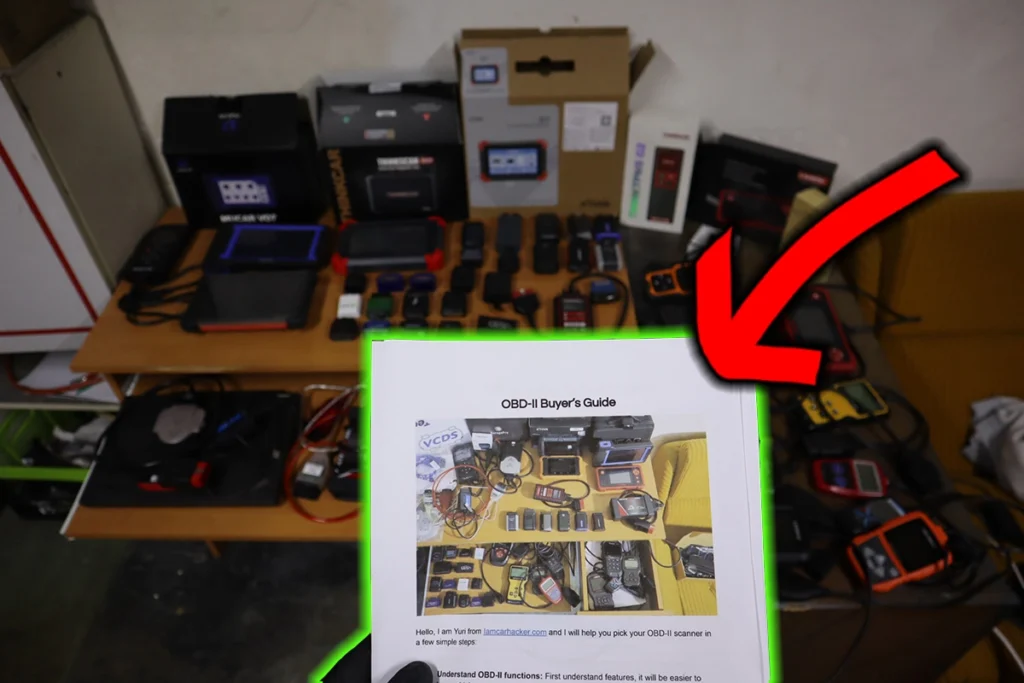The code P2097: Post Catalyst Fuel Trim System Too Rich Bank 1 indicates an issue where the fuel mixture is too rich (too much fuel or not enough air) in Bank 1 of the engine after the catalytic converter. This problem is commonly caused by issues such as faulty oxygen sensors, vacuum or exhaust leaks, or problems in the fuel delivery system.
P2097 quick overview
| Meaning | P2097: Post Catalyst Fuel Trim System Too Rich Bank 1 |
| Is it serious? | Yes, it can affect engine performance and emissions, and may lead to more serious issues if not addressed. |
| Possible causes | – Faulty or contaminated oxygen sensor – Vacuum leaks in the intake manifold or hoses – Exhaust leaks near the downstream oxygen sensor – Fuel pressure or volume issues – Faulty fuel injectors – Loose intake manifold or faulty gaskets – Engine Control Module (ECM) software needing an update |
| How to diagnose? | Inspect Oxygen Sensors: Check the condition and operation of the post-catalyst oxygen sensor. Check for Vacuum Leaks: Inspect intake manifold, hoses, and connections for leaks. Evaluate Exhaust System: Look for leaks in the exhaust system, especially near sensors. Monitor Fuel Pressure: Ensure fuel pressure and volume are within specifications. Inspect Intake Manifold: Check the manifold and gaskets for looseness or leaks. Scan for Other Codes: Look for additional diagnostic trouble codes that may provide more information. Update ECM Software: Check for any TSBs related to ECM software updates. |
In simpler terms, the P2097 code means that the part of your engine that controls the balance of air and fuel (Bank 1) is getting too much fuel after it passes through the pollution control device (catalytic converter). This could be due to a variety of reasons, like sensor problems, leaks, or fuel delivery issues, and it’s something that should be checked to keep your car running properly and avoid more serious problems down the road.
Free PDF: How to choose OBD2 scanner

I’ve made you a free PDF to choose the OBD2 scanner in 5 minutes.
✅ Which OBD2 scanner is best?
✅ Which type should you get (DIY, Pro, Hobby)
✅ What is the best scanner for the exact brand/feature (e.g best for BMW)
✅ How to get a Bi-Directional tool for as cheap as $40
✅ Discount coupons for scanners
PDF is 100% free and it is designed to help you pick a scanner in less than a few minutes! Not a boring 50-page guide.
Just tell me where to send it.
How to fix P2097 – learn from mechanics
I looked into P2097 service cases at iatn.com website where in the private forums the mechanics seek advice from other mechanics. I looked up a bunch of cases to help you decide how to fix your issue and see what would a real mechanic do to solve it.
Case #1: Nissan
Vehicle Information
- 2013 Nissan Pathfinder S 3.5L
Issue + Repair History
- MIL Lamp on.
- Code: P2097 sets in 2-7 days, typically at high speeds.
- Repairs: Fixed leak between exhaust manifold and B1 catalytic converter, replaced OEM A/F sensor for bank 1.
- Actions taken: Smoke-tested intake tract (no leaks), pressurized exhaust system (fixed one leak).
Other OBD2 Codes + Test Results
- P2097 – Post catalyst fuel trim system too rich bank 1
Suggestions to Fix Issue
- Monitor post-catalytic sensor readings for both banks during a road test.
- Swap downstream sensors to see if the code follows.
- Consider replacing the downstream sensor.
- Check fuel pressure and injection pulse width.
- Inspect harness connections for water or damage.
- Evaluate the possibility of a leaking fuel injector.
Final Fix
- Replaced the rear O2 sensor on bank 1.
- After repair, no recurrence of the P2097 code.
Case #2: Mazda
Vehicle Information
- 2004 Mazda RX-8 1.3L
Issue + Repair History
- MIL Lamp on.
- Code: P2097 (target A/F feedback system too rich).
- Repairs: Replaced rear O2 sensor, code returned after one warm-up cycle.
Other OBD2 Codes + Test Results
- P2097 – Target A/F feedback system too rich
Suggestions to Fix Issue
- Check the operation of the post-catalytic sensor for both banks.
- Inspect for a defective catalytic converter.
- Monitor fuel pressure and injection pulse width.
- Test for exhaust leaks between manifold and first O2 sensor.
- Evaluate fuel injection system and potential PCM issues.
Final Fix
- Replaced the thermostat.
- Vehicle was taking too long to warm up, causing the PCM to set the P2097 code.
- After replacement, no pending codes were set and monitors ran successfully.
Case #3: Subaru
Vehicle Information
- 2005 Subaru Forester X 2.5L
Issue + Repair History
- Intermittent surge or buck while driving.
- MIL Lamp on.
- Codes: P0641 (Sensor reference voltage A circuit open) and P2097 (Post catalyst fuel trim system too rich bank 1).
- Repairs: Throttle housing and rear O2 sensor replaced.
Other Test Results
- P2097 – Post catalyst fuel trim system too rich bank 1
- Readings for A/F ratio sensor and rear O2 sensor within normal range most of the time.
Suggestions to Fix Issue
- Possible catalytic converter issue, internal restriction.
- TSB for P2097 involving ECU reflash and A/F sensor replacement.
- Check A/F sensor and post-cat sensor responses to forced-rich and lean conditions.
- Inspect for any corrosion on harness connectors.
- Evaluate if vehicle modifications might affect sensor readings.
Final Fix
- Replaced front A/F sensor.
- Performed ECU software update (flash) as per TSB.
- After fix, rear O2 sensor began cycling properly, and customer reported the problem resolved.
Case #4: Mini
Vehicle Information
- 2008 Mini Cooper S Clubman 1.6L
Issue + Repair History
- Check engine light on, running poorly.
- Codes: P1497, P2178 (System too rich off idle bank 1), P2096 (Post cat fuel trim too lean bank 1), P2097 (Post cat fuel trim too rich bank 1).
- Actions taken: Checked spark plugs, cleaned MAF, performed Motorvac carbon clean, resulting in improved performance but with low rpm hesitation.
Computer Codes & Descriptions
- P1497 – Unspecified code, possibly related to fuel trim.
- P2178 – System too rich off idle bank 1.
- P2096 – Post catalyst fuel trim system too lean bank 1.
- P2097 – Post catalyst fuel trim system too rich bank 1.
Suggestions to Fix Issue
- Check valve cover and PCV system for issues, as plugging can occur.
- Inspect the air boot coming off the throttle body for cracks, especially at plastic weld joints.
- Consider the possibility of unmetered air leaks.
Final Fix
- Replaced valve cover and rear PCV hose.
- After replacement, the car initially ran well without hesitation.
- The customer reported the car running worse than before after picking it up.
Case #5: Chevrolet
Vehicle Information
- 2014 Chevrolet Malibu LT 2.5L
Issue + Repair History
- Surge and cut out after driving a bit.
- Codes: P0171 and P2097, both indicating lean conditions.
- Replaced MAP sensor (initially had MAP sensor code).
- O2 sensors reading zero and fuel trim going lean intermittently during driving.
- Replaced MAF sensor, but it didn’t resolve the issue.
Computer Codes & Descriptions
- P0171 – System too lean.
- P2097 – Post catalyst fuel trim system too rich bank 1.
Suggestions to Fix Issue
- Check high and low side fuel pressure and VVT data.
- Inspect fuel pressure and volume.
- Consider the possibility of a faulty purge valve.
- Check if intake bolts are loose; common issue on this engine.
Final Fix
- Found intake manifold was loose.
- Replaced intake gasket.
- After repair, the vehicle ran well without issues.
How to diagnose P2097
I made you an overview of solving this DTC, based on all the advice that was suggested by certified mechanics to address this issue in previously mentioned service cases.
| Advice | Diagnostic Step Description |
|---|---|
| Check for Vacuum Leaks | Inspect the intake manifold, hoses, and connections for vacuum leaks, as they can cause lean or rich conditions. |
| Inspect Oxygen Sensors | Verify the condition and operation of both pre- and post-catalyst oxygen sensors, as they directly influence fuel trim. |
| Evaluate Fuel System | Check fuel pressure and volume to ensure the fuel system is operating correctly, as issues here can trigger the code. |
| Monitor Fuel Trims | Use a scan tool to observe short-term and long-term fuel trims, particularly during the conditions when the issue occurs. |
| Check Intake Manifold and Gaskets | Inspect the intake manifold for looseness and the gaskets for leaks, as these can cause air-fuel mixture issues. |
| Update Engine Control Module (ECM) Software | Consider if there’s a Technical Service Bulletin (TSB) for an ECM software update related to this code. |
| Replace Affected Sensors | If diagnostics point to a faulty sensor (such as an O2 or A/F sensor), replace it with an OE part for accuracy. |
Free PDF: How to choose OBD2 scanner

I’ve made you a free PDF to choose the OBD2 scanner in 5 minutes.
✅ Which OBD2 scanner is best?
✅ Which type should you get (DIY, Pro, Hobby)
✅ What is the best scanner for the exact brand/feature (e.g best for BMW)
✅ How to get a Bi-Directional tool for as cheap as $40
✅ Discount coupons for scanners
PDF is 100% free and it is designed to help you pick a scanner in less than a few minutes! Not a boring 50-page guide.
Just tell me where to send it.

Hi, I am Juraj “Yuri” Lukacko. I got frustrated by unhelpful and scammy mechanics, so I decided to learn everything about car diagnostics myself. I test dozens of new car diagnostic tools every month along with learning new strategies to fix and customize cars. About Juraj Lukacko (Yuri)